Description
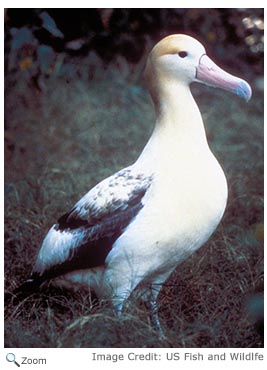 The short-tailed albatross is a large seabird, 33-36 inches in lenght, with a 7 foot wingspan. It has light yellowish-brown feathers on its head and the back of its neck and a white chest and belly. It has black and white wings, yellow feet, and a large pink bill with a blue tip. Juvinile short-tail albatrosses are brown. Despite its name, the tail of the short-tailed albatross is not shorter than the tails of other albatross species. The short-tailed albatross is a large seabird, 33-36 inches in lenght, with a 7 foot wingspan. It has light yellowish-brown feathers on its head and the back of its neck and a white chest and belly. It has black and white wings, yellow feet, and a large pink bill with a blue tip. Juvinile short-tail albatrosses are brown. Despite its name, the tail of the short-tailed albatross is not shorter than the tails of other albatross species.
Range
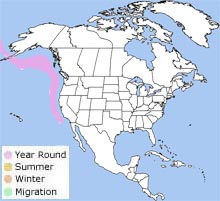 The short-tailed albatross was once found in large numbers in the North Pacific Ocean around the seas of Taiwan and Japan. Today, the short-tailed albatross breeds on two islands in the Pacific Ocean. It occasionally is sighted off the Pacific Coast of the United States, south to California. The short-tailed albatross was once found in large numbers in the North Pacific Ocean around the seas of Taiwan and Japan. Today, the short-tailed albatross breeds on two islands in the Pacific Ocean. It occasionally is sighted off the Pacific Coast of the United States, south to California.
Habitat
The short-tailed albatross lives on open ocean waters and islands. |
|
Diet
The short-tailed albatross is a surface eater. Its diet includes flying fish eggs, crustaceans, and squid. It will sometimes follow ships and eat what is thrown overboard. It usually feeds in the early morning and at twilight.
Life Cycle
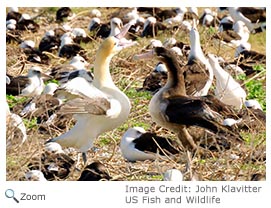 Short-tailed albatrosses begin breeding when they are 6-7 years old. Pair mate for life and return to the same nesting site year-after-year. Short-tailed albatrosses begin breeding when they are 6-7 years old. Pair mate for life and return to the same nesting site year-after-year.
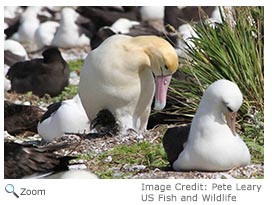 The female lays a single egg. The chick hatches in a little over two months and stays in the nest for up to five months. The female lays a single egg. The chick hatches in a little over two months and stays in the nest for up to five months.
Behavior 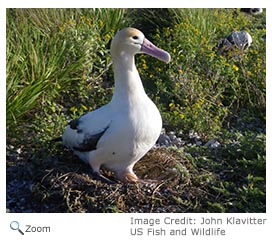 At the turn of the 20th century, close to five million short-tailed albatrosses were killed for their feathers. In fact, the short-tailed albatross was thought to be extinct until 1951 when a colony was discovered in Torishima Islands south of Japan. A second nesting colony was discovered on Minami-kojima Island south of Taiwan in 1979. Conservation efforts have increased the world-wide population of the short-tailed albatross to close to 1,000 birds. At the turn of the 20th century, close to five million short-tailed albatrosses were killed for their feathers. In fact, the short-tailed albatross was thought to be extinct until 1951 when a colony was discovered in Torishima Islands south of Japan. A second nesting colony was discovered on Minami-kojima Island south of Taiwan in 1979. Conservation efforts have increased the world-wide population of the short-tailed albatross to close to 1,000 birds.
|


 The short-tailed albatross was once found in large numbers in the North Pacific Ocean around the seas of Taiwan and Japan. Today, the short-tailed albatross breeds on two islands in the Pacific Ocean. It occasionally is sighted off the Pacific Coast of the United States, south to California.
The short-tailed albatross was once found in large numbers in the North Pacific Ocean around the seas of Taiwan and Japan. Today, the short-tailed albatross breeds on two islands in the Pacific Ocean. It occasionally is sighted off the Pacific Coast of the United States, south to California. 

